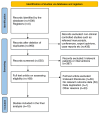Comparison between minimally invasive and open transforaminal lumbar interbody fusion for the treatment of multi‑segmental lumbar degenerative disease: A systematic evaluation and meta‑analysis
- PMID: 38476911
- PMCID: PMC10928985
- DOI: 10.3892/etm.2024.12450
Comparison between minimally invasive and open transforaminal lumbar interbody fusion for the treatment of multi‑segmental lumbar degenerative disease: A systematic evaluation and meta‑analysis
Abstract
The present study aimed to compare the differences between minimally invasive transforaminal lumbar fusion (MIS-TLIF) and open transforaminal lumbar fusion (TLIF) for multi-segmental lumbar degenerative disease regarding intraoperative indices and postoperative outcomes. PubMed, Web of Science, Embase, CNKI, Wanfang and VIP databases were searched for literature on MIS-TLIF and open TLIF in treating multi-segmental lumbar degenerative diseases. Of the 1,608 articles retrieved, 10 were included for final analysis. The Newcastle-Ottawa Scale and Review Manager 5.4 were used for quality evaluation and data analysis, respectively. The MIS-TLIF group was superior to the open TLIF group regarding intraoperative blood loss [95% confidence interval (CI): -254.33,-157.86; P<0.00001], postoperative in-bed time (95%CI: -3.49,-2.76; P<0.00001), hospitalization time (95%CI: -5.14,-1.78; P<0.0001) and postoperative leg pain Visual Analog Scale score (95%CI: -0.27,-0.13; P<0.00001). The fluoroscopy frequency for MIS-TLIF (95%CI: 2.07,6.12; P<0.0001) was significantly higher than that for open TLIF. The two groups had no significant differences in operation time, postoperative drainage volume, postoperative complications, fusion rate, or Oswestry Disability Index score. In treating multi-segmental lumbar degenerative diseases, MIS-TLIF has the advantages of less blood loss, shorter bedtime and hospitalization time and improved early postoperative efficacy; however, open TLIF has a lower fluoroscopy frequency.
Keywords: lumbar degenerative disease; meta-analysis; minimally invasive transforaminal lumbar fusion; multi-segment; open transforaminal lumbar fusion.
Copyright: © 2024 Zhai et al.
Conflict of interest statement
The authors declare that they have no competing interests.
Figures













Similar articles
-
Minimally invasive versus open transforaminal lumbar interbody fusion for single segmental lumbar disc herniation: A meta-analysis.J Back Musculoskelet Rehabil. 2022;35(3):505-516. doi: 10.3233/BMR-210004. J Back Musculoskelet Rehabil. 2022. PMID: 34602458 Free PMC article.
-
Short-term clinical efficacy and safety of unilateral biportal endoscopic transforaminal lumbar interbody fusion versus minimally invasive transforaminal lumbar interbody fusion in the treatment of lumbar degenerative diseases: a systematic review and meta-analysis.J Orthop Surg Res. 2023 Sep 4;18(1):656. doi: 10.1186/s13018-023-04138-0. J Orthop Surg Res. 2023. PMID: 37667363 Free PMC article.
-
Comparing the efficacy of unilateral biportal endoscopic transforaminal lumbar interbody fusion and minimally invasive transforaminal lumbar interbody fusion in lumbar degenerative diseases: a systematic review and meta-analysis.J Orthop Surg Res. 2023 Nov 22;18(1):888. doi: 10.1186/s13018-023-04393-1. J Orthop Surg Res. 2023. PMID: 37993948 Free PMC article.
-
Comparison of Clinical Outcomes and Complications Between Percutaneous Endoscopic and Minimally Invasive Transforaminal Lumbar Interbody Fusion for Degenerative Lumbar Disease: A Systematic Review and Meta-Analysis.Pain Physician. 2021 Sep;24(6):441-452. Pain Physician. 2021. PMID: 34554684
-
[Two different techniques combined with MIS-TLIF in the treatment of degenerative lumbar spondylolisthesis:a case-control study].Zhongguo Gu Shang. 2022 May 25;35(5):409-17. doi: 10.12200/j.issn.1003-0034.2022.05.002. Zhongguo Gu Shang. 2022. PMID: 35535527 Chinese.
Cited by
-
Comparison of the short-term efficacy of MIS-TLIF and Endo-LIF for the treatment of two-segment lumbar degenerative disease.BMC Musculoskelet Disord. 2024 Sep 4;25(1):708. doi: 10.1186/s12891-024-07815-1. BMC Musculoskelet Disord. 2024. PMID: 39232720 Free PMC article.
References
-
- Zhang YW, Deng L, Zhang XX, Yu XL, Ai ZZ, Mei YX, He F, Yu H, Zhang L, Xiao X, et al. Three-dimensional printing-assisted cervical anterior bilateral pedicle screw fixation of artificial vertebral body for cervical tuberculosis. World Neurosurg. 2019;127:25–30. doi: 10.1016/j.wneu.2019.03.238. - DOI - PubMed
LinkOut - more resources
Full Text Sources
